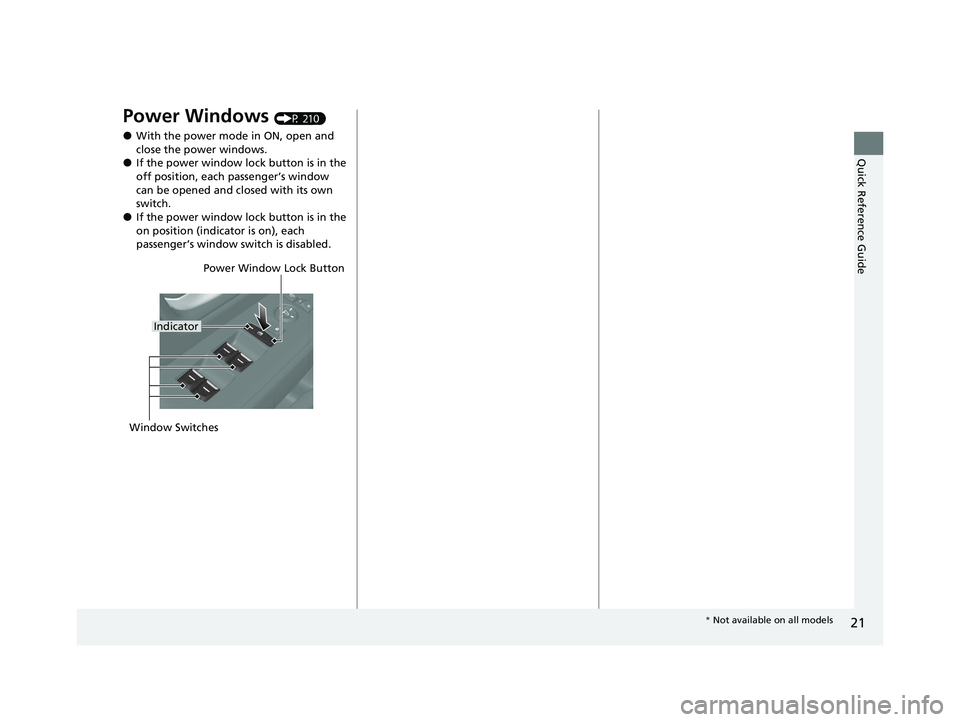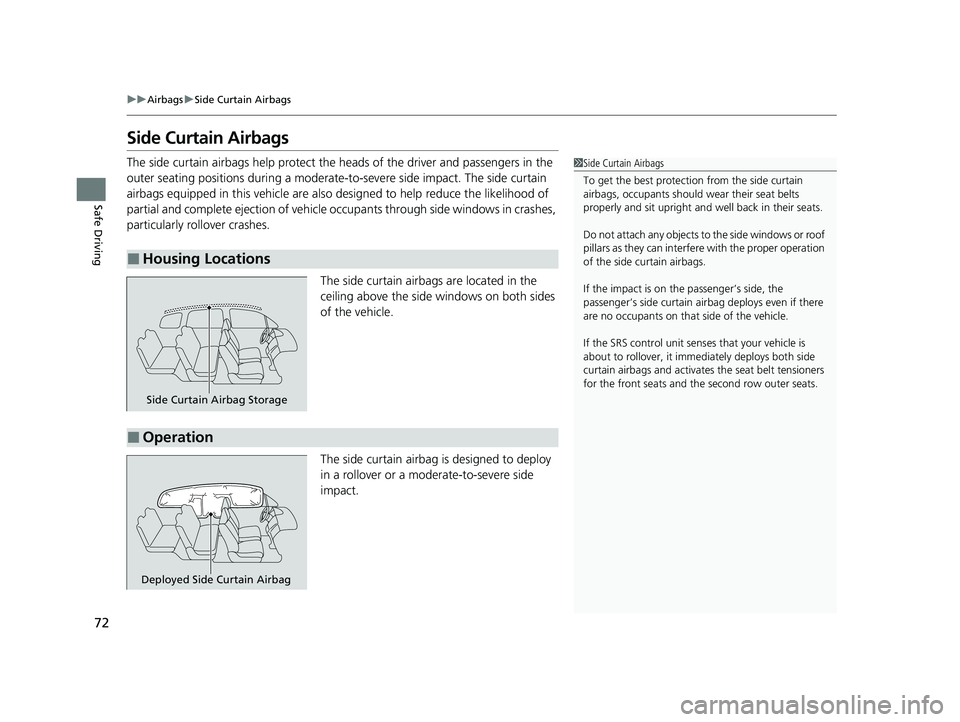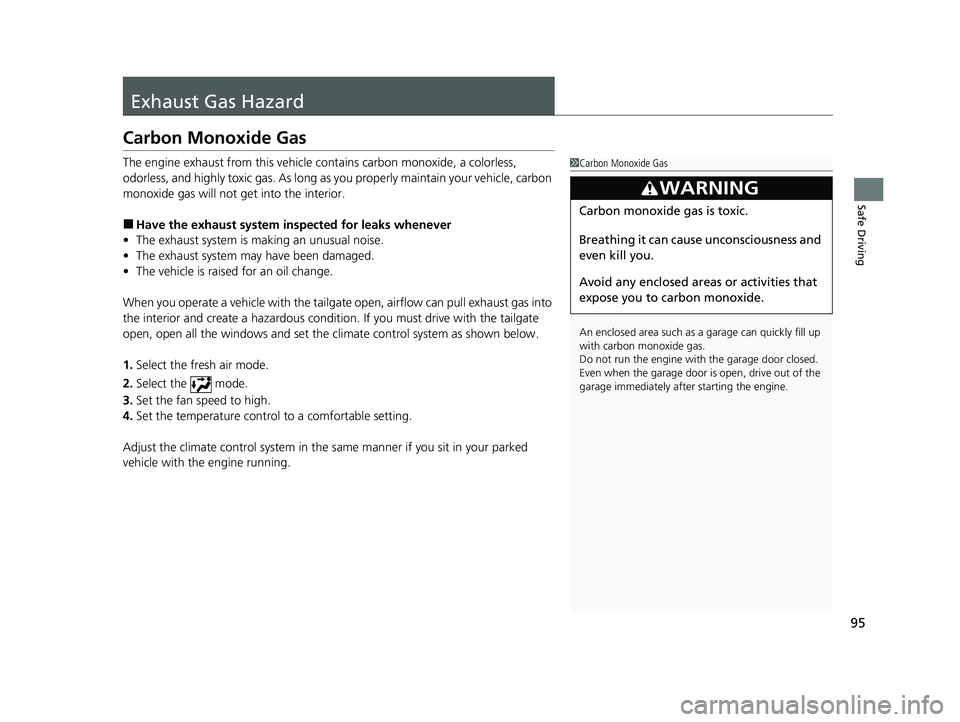2023 HONDA PILOT window
[x] Cancel search: windowPage 8 of 814

Contents
Child Safety P. 77Exhaust Gas Hazard P. 95Safety Labels P. 96
Tailgate P. 196 Security System P. 207 Windows P. 210
Operating the Switches Around the Steering Wheel P. 217 Mirrors P. 236
Climate Control System P. 283
Audio Error Messages P. 398 General Information on the Audio System P. 400
Bluetooth ® HandsFreeLink ® P. 459, 479 Refuel Recommend P. 498
Off-Highway Driving Guidelines P. 519 When Driving P. 524 Honda Sensing ® P. 567 Braking P. 652
Surround View Camera System* P. 674 Refueling P. 686 Fuel Economy and CO2 Emissions P. 689
Maintenance Under the Hood P.705 Replacing Light Bulbs P. 718
Checking and Maintaining Tires P. 728 Batt ery P. 737 Remote Transmitter Care P. 739
Accessories and Modifications P. 747
Engine Does Not Start P. 762 If the Battery Is Dead P. 767
Fuses P. 778 Emergency Towing P. 785
If You Cannot Open the Tailgate P. 787 Refueling P. 788
Devices that Emit Radio Waves P. 793 Reporting Safety Defects P. 794
Authorized Manuals P. 800 Customer Service Information P. 801 Open Source License P. 802
Quick Reference GuideP. 8
Safe DrivingP. 37
Instrument PanelP. 97
ControlsP. 175
FeaturesP. 291
DrivingP. 501
MaintenanceP. 691
Handling the UnexpectedP. 749
InformationP. 789
IndexP. 804
23 PILOT-31T906000_03.book 7 ページ 2022年10月31日 月曜日 午前10時26分
Page 11 of 814

Visual Index
10
Quick Reference Guide❚Power Window Switches (P210)
❚Memory Buttons* (P234)
❚SET Button* (P234)
❚Driver’s Front Airbag (P62)
❚Hood Release Handle (P706)
❚Glove Box (P263)
❚Driver’s Knee Airbag (P67)
❚Accessory Power Socket (P273)
❚Rearview Mirror (P236)
❚HomeLink® Buttons* (P457)
❚Passenger’s Front Airbag (P62)
❚Door Mirror Controls (P237)
❚Master Door Lock Switch (P194)
❚USB Ports (P293)
❚Passenger’s Knee Airbag (P67)
❚Wireless Charger* (P275)
❚Interior Fuse Box (P782)
❚Interior Fuse Box (P780)
23 PILOT-31T906000_03.book 10 ページ 2022年10月31日 月曜日 午前10時26分
Page 22 of 814

21
Quick Reference Guide
Power Windows (P 210)
●With the power mode in ON, open and
close the power windows.
●If the power window lock button is in the
off position, each passenger’s window
can be opened and closed with its own
switch.
●If the power window lock button is in the
on position (indicator is on), each
passenger’s window switch is disabled.
Power Window Lock Button
Window Switches
Indicator
* Not available on all models
23 PILOT-31T906000_03.book 21 ページ 2022年10月31日 月曜日 午前10時26分
Page 61 of 814

60
uuAirbags uAirbag System Components
Safe Driving
The front, driver’s knee, front passenger’s
knee, side, and side curtain airbags are
deployed according to the direction and
severity of impact. Both side curtain airbags
are deployed in a ro llover. The airbag
system includes:
aTwo SRS (Supplemental Restraint System)
front airbags. The driver’s airbag is stored
in the center of the steering wheel; the
front passenger’s airbag is stored in the
dashboard. Both are marked SRS
AIRBAG.
bTwo knee airbags. Th e driver’s knee
airbag is stored under the steering
column; the front passenger’s knee
airbag is stored under the glove box.
Both are marked SRS AIRBAG.
cTwo side airbags, one for the driver and
one for the front passenger. The airbags
are stored in the outer edges of the seat-
backs. Both are marked SIDE AIRBAG .
dTwo side curtain airbags, one for each
side of the vehicle. The airbags are stored
in the ceiling, above the side windows.
The front and rear pillars are marked
SIDE CURTAIN AIRBAG.
eAn electronic control unit that, when the
power mode is in ON, continually
monitors information about the various
impact sensors, seat and buckle sensors,
rollover sensor, airbag activators, seat
belt tensioners, and other vehicle
information. During a crash event the
unit can record such information.
fAutomatic seat belt tensioners for the
front seats and the second row outer
seats. In addition, the driver’s and front
passenger’s seat belt buckles incorporate
sensors that detect whether or not the
belts are fastened.
gDriver’s seat position sensor. This sensor
detects the driver’s seat slide position to
help determine the optimal deployment
of the driver’s airbag.
hWeight sensors in the front passenger’s
seat. The sensors are used for occupant
classification to activa te or deactivate the
front passenger’s airbag.
iImpact sensors that can detect a
moderate-to-severe front or side impact.
jAn indicator on the dashboard that alerts
you that the front passenger’s front
airbag has been turned off.
kAn indicator on the instrument panel that
alerts you to a possib le problem with your
airbag system or seat belt tensioners.
lSafing Sensor
mA rollover sensor that can detect if your
vehicle is about to roll over and signal the
control unit to deploy both side curtain
airbags.
nPressure sensors inside each front door
that control side airbag deployment.
23 PILOT-31T906000_03.book 60 ページ 2022年10月31日 月曜日 午前10時26分
Page 63 of 814

62
uuAirbags uTypes of Airbags
Safe Driving
Types of Airbags
Your vehicle is equipped with four types of airbags:
• Front airbags: Airbags in front of the driver ’s and front passenger’s seats.
• Knee airbags: Airbags under the steering column and under the glove box.
• Side airbags: Airbags in the driver’s and front passenger’s seat-backs.
• Side curtain airbags: Airbags above the side windows.
Each is discussed in the following pages.
Front Airbags (SRS)
The front SRS airbags inflate in a moderate-to -severe frontal collision to help protect
the head and chest of the driver and/or front passenger.
SRS (Supplemental Restraint System) indica tes that the airbags are designed to
supplement seat belts, not replace them. Seat belts are the occupant’s primary
restraint system.
The front airbags are housed in the center of the steering wheel for the driver, and
in the dashboard for the front pass enger. Both airbags are marked SRS AIRBAG.
■Housing Locations
1Types of Airbags
The airbags can inflate whenever the power mode is
in ON.
After an airbag inflates in a crash, you may see a
small amount of smoke. This is from the combustion
process of the infl ator material and is not harmful.
People with respiratory pr oblems may experience
some temporary discomfort. If this occurs, get out of
the vehicle as soon as it is safe to do so.
1 Front Airbags (SRS)
During a frontal crash severe enough to cause one or
both front airbags to deploy, the airbags can inflate
at different rates, dependi ng on the severity of the
crash, whether or not the se at belts are latched, and/
or other factors. Frontal airbags are designed to
supplement the seat belts to help reduce the
likelihood of head and chest injuries in frontal
crashes.
23 PILOT-31T906000_03.book 62 ページ 2022年10月31日 月曜日 午前10時26分
Page 73 of 814

72
uuAirbags uSide Curtain Airbags
Safe Driving
Side Curtain Airbags
The side curtain airbags help protect the heads of the driver and passengers in the
outer seating positions during a moderate-to -severe side impact. The side curtain
airbags equipped in this vehicle are also designed to help reduce the likelihood of
partial and complete ejection of vehicle occupants through side windows in crashes,
particularly rollover crashes.
The side curtain airbags are located in the
ceiling above the side windows on both sides
of the vehicle.
The side curtain airbag is designed to deploy
in a rollover or a moderate-to-severe side
impact.
■Housing Locations
1Side Curtain Airbags
To get the best protecti on from the side curtain
airbags, occupants should wear their seat belts
properly and sit upr ight and well back in their seats.
Do not attach any objects to the side windows or roof
pillars as they can interfere with the proper operation
of the side curtain airbags.
If the impact is on the passenger’s side, the
passenger’s side curtain airbag deploys even if there
are no occupants on that side of the vehicle.
If the SRS control unit sens es that your vehicle is
about to rollover, it imme diately deploys both side
curtain airbags and activates the seat belt tensioners
for the front seats and the second row outer seats.
Side Curtain Airbag Storage
■Operation
Deployed Side Curtain Airbag
23 PILOT-31T906000_03.book 72 ページ 2022年10月31日 月曜日 午前10時26分
Page 79 of 814

uuChild Safety uProtecting Child Passengers
78
Safe Driving
• Never hold a child on your lap because it is impossible to protect them in the
event of a collision.
• Never put a seat belt over yourself and a child. During a crash, the belt would
likely press deep into the child an d cause serious or fatal injuries.
• Never let two children use the same seat belt. Both children could be very
seriously injured in a crash.
• Any child who is too small to wear a seat belt correctly must be restrained in an
approved child seat that is properly secu red to the vehicle using either the seat
belt or the lower anchor s of the LATCH system.
• Do not allow children to operate the doors, windows, or seat adjustments.
• Do not leave children in the vehicle unattended, especially in hot weather when
the inside of the vehicle can get hot enough to kill them. They could also activate
vehicle controls, causing it to move unexpectedly.1 Protecting Child Passengers
To deactivate a lockable retractor, release the buckle
and allow the seat belt to wind up all the way.
To remind you of the pa ssenger’s front airbag
hazards and child safety, your vehicle has warning
labels on the dashboard (U.S. models) and on the
front visors. Please read and follow the instructions
on these labels. 2 Safety Labels P. 96
3WARNING
Allowing a child to play with a seat belt or
wrap one around their neck can result in
serious injury or death.
Instruct children not to play with any seat
belt and make sure any unused seat belt a
child can reach is buckled, fully retracted,
and locked.
23 PILOT-31T906000_03.book 78 ページ 2022年10月31日 月曜日 午前10時26分
Page 96 of 814

95
Safe Driving
Exhaust Gas Hazard
Carbon Monoxide Gas
The engine exhaust from this vehicle contains carbon monoxide, a colorless,
odorless, and highly toxic gas. As long as you properly maintain your vehicle, carbon
monoxide gas will not get into the interior.
■Have the exhaust system in spected for leaks whenever
• The exhaust system is making an unusual noise.
• The exhaust system may have been damaged.
• The vehicle is raised for an oil change.
When you operate a vehicle with the tailga te open, airflow can pull exhaust gas into
the interior and create a hazardous conditio n. If you must drive with the tailgate
open, open all the windows and set the climate control system as shown below.
1. Select the fresh air mode.
2. Select the mode.
3. Set the fan speed to high.
4. Set the temperature control to a comfortable setting.
Adjust the climate control system in the same manner if you sit in your parked
vehicle with the engine running.
1 Carbon Monoxide Gas
An enclosed area such as a garage can quickly fill up
with carbon monoxide gas.
Do not run the engine with the garage door closed.
Even when the garage door is open, drive out of the
garage immediat ely after starting the engine.
3WARNING
Carbon monoxide gas is toxic.
Breathing it can cause unconsciousness and
even kill you.
Avoid any enclosed areas or activities that
expose you to carbon monoxide.
23 PILOT-31T906000_03.book 95 ページ 2022年10月31日 月曜日 午前10時26分